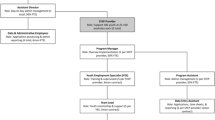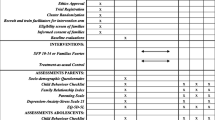Abstract
Purpose
Sexual violence (SV) and adolescent relationship abuse (ARA) are common in the U. S. and have strong associations with negative health and wellbeing outcomes. Manhood 2.0 is the first U.S. program designed for community settings to build bystander skills while also challenging harmful gender norms. A cluster-randomized trial comparing Manhood 2.0 to Job Skills, a job readiness training control condition, demonstrated that it is a promising strategy to prevent sexual violence and adolescent relationship abuse. Such community-based interventions may be particularly relevant in lower resource urban settings, and the costs of such prevention programs have not been considered previously.
Methods
The aim of the present study is to perform systematic and standardized cost calculations associated with implementing Manhood 2.0 among adolescent males. In addition, this study provides detailed cost information of the community-based intervention program, as well as costs associated with implementing the Job Skills control program. Program implementation data were recorded throughout the study period (2015–2019) by the Manhood 2.0 study team.
Results
The cost of implementing Manhood 2.0 is $4,771 per complete round of program delivery and $451 per participant, which is approximately the same cost as the control Job Skills program ($4,432 and $453 per participant). The marginal cost per additional round of Manhood 2.0 program is $3,682.
Conclusion
Implementation of a community-based program requires substantial resources and collaborations with community partners especially in economically disadvantaged neighborhoods. This study provides a snapshot of the cost information of a community-based intervention program from the implementing agency’s perspective, which is essential in helping decision-makers understand the costs they will incur by implementing prevention programs and ensuring program feasibility and sustainability.
Similar content being viewed by others
References
Abebe, K. Z., Jones, K. A., Culyba, A. J., Feliz, N. B., Anderson, H., Torres, I., Zelazny, S., Bamwine, P., Boateng, A., Cirba, B., Detchon, A., Devine, D., Feinstein, Z., Macak, J., Massof, M., Miller-Walfish, S., Morrow, S. E., Mulbah, P., Mulwa, Z., & Miller, E. (2018). Engendering healthy masculinities to prevent sexual violence: Rationale for and design of the Manhood 2.0 trial. Contemporary Clinical Trials, 71, 18–32. https://doi.org/10.1016/j.cct.2018.05.017.
Alang, S., McAlpine, D. D., & Hardeman, R. (2020). Police brutality and mistrust in Medical Institutions. Journal of Racial and Ethnic Health Disparities, 7(4), 760–768. https://doi.org/10.1007/s40615-020-00706-w.
Basile, K. C., Clayton, H. B., DeGue, S., Gilford, J. W., Vagi, K. J., Suarez, N. A., Zwald, M. L., & Lowry, R. (2020). Interpersonal Violence Victimization Among High School Students - Youth Risk Behavior Survey, United States, 2019. MMWR Suppl, 69(1), 28–37. https://doi.org/10.15585/mmwr.su6901a4
Basile, K. C., DeGue, S., Jones, K., Freire, K., Dills, J., Smith, S. G., & Raiford, J. L. (2016). A technical package to prevent sexual violence. National Center for Injury Prevention and Control, Centers for Disease Control and Prevention. https://www.cdc.gov/violenceprevention/pdf/sv-prevention-technical-package.pdf.
Boynton-Jarrett, R., Raj, A., & Inwards-Breland, D. J. (2021). Structural integrity: Recognizing, measuring, and addressing systemic racism and its health impacts. EClinicalMedicine, 36, 100921. https://doi.org/10.1016/j.eclinm.2021.100921
Center for Disease Control and Prevention (2016). Preventing multiple forms of violence: a strategic vision for connecting the dots. Division of Violence Prevention, National Center for Injury Prevention and Control, Centers for Disease Control and Prevention. https://www.cdc.gov/violenceprevention/pdf/strategic_vision.pdf
Center for the Study and Prevention of Violence (2011). Blueprints for Violence Prevention. www.colorado.edu/cspv/blueprints.
Coker, A. L., Bush, H. M., Cook-Craig, P. G., DeGue, S. A., Clear, E. R., Brancato, C. J., Fisher, B. S., & Recktenwald, E. A. (2017). RCT Testing Bystander Effectiveness to reduce violence. American Journal Of Preventive Medicine, 52(5), 566–578. https://doi.org/10.1016/j.amepre.2017.01.020.
Eugene, J. M., Zelazny, S., Torres, I., Feliz, N., Bamwine, P., Jones, K., & Miller, E. (2017). Using Community Asset Mapping and Respondent-Driven Sampling to Support Recruitment and Retention for a community-based sexual violence Prevention Program. Journal Of Adolescent Health, 60(2), S79. https://doi.org/10.1016/j.jadohealth.2016.10.338.
Exner-Cortens, D., Eckenrode, J., & Rothman, E. (2013). Longitudinal associations between teen dating violence victimization and adverse health outcomes. Pediatrics, 131(1), 71–78. https://doi.org/10.1542/peds.2012-1029.
Ferrari, G., Torres-Rueda, S., Chirwa, E., Gibbs, A., Orangi, S., Barasa, E., Tawiah, T., Dwommoh Prah, R. K., Hitimana, R., Daviaud, E., Kapapa, E., Dunkle, K., Heise, L., Stern, E., Chatterji, S., Omondi, B., Ogum Alangea, D., Karmaliani, R., Khuwaja, M. A., & Vassall, H., A (2022). Prevention of violence against women and girls: a cost-effectiveness study across 6 low- and middle-income countries. PLOS Medicine, 19(3), e1003827. https://doi.org/10.1371/journal.pmed.1003827.
Haddix, A. C., Teutsch, S. M., & Corso, P. S. (2002). Prevention effectiveness: a guide to decision analysis and economic evaluation. Oxford University Press.
Hemphill, S. A., Toumbourou, J. W., Herrenkohl, T. I., McMorris, B. J., & Catalano, R. F. (2006). The effect of school suspensions and arrests on subsequent adolescent antisocial behavior in Australia and the United States. Journal Of Adolescent Health, 39(5), 736–744. https://doi.org/10.1016/j.jadohealth.2006.05.010.
Kato-Wallace, J., Barker, G., Garg, A., Feliz, N., Levack, A., Ports, K., & Miller, E. (2019). Adapting a global gender-transformative violence Prevention Program for the U.S. community-based setting for work with Young Men. Glob Soc Welf, 6(2), 121–130. https://doi.org/10.1007/s40609-018-00135-y.
Leight, J., Deyessa, N., & Sharma, V. (2021). Cost-effectiveness analysis of an intimate partner violence prevention intervention targeting men, women and couples in rural Ethiopia: evidence from the Unite for a Better Life randomised controlled trial. British Medical Journal Open, 11(3), e042365. https://doi.org/10.1136/bmjopen-2020-042365.
Luo, F., DeGue, S., & Le, V. D. (2022). Estimating from the Payer Perspective the implementation cost of dating Matters®: a Comprehensive Teen dating violence Prevention Model. J Interpers Violence, 37(11–12), https://doi.org/10.1177/0886260520980389. Np9144-np9167.
Miller, E., Jones, K. A., Culyba, A. J., Paglisotti, T., Dwarakanath, N., Massof, M., Feinstein, Z., Ports, K. A., Espelage, D., Pulerwitz, J., Garg, A., Kato-Wallace, J., & Abebe, K. Z. (2020). Effect of a community-based gender norms program on sexual violence perpetration by adolescent Boys and Young Men: a Cluster Randomized Clinical Trial. JAMA Netw Open, 3(12), e2028499–e2028499. https://doi.org/10.1001/jamanetworkopen.2020.28499.
Miller, E., Tancredi, D. J., McCauley, H. L., Decker, M. R., Virata, M. C., Anderson, H. A., Stetkevich, N., Brown, E. W., Moideen, F., & Silverman, J. G. (2012). “Coaching boys into men”: a cluster-randomized controlled trial of a dating violence prevention program. Journal Of Adolescent Health, 51(5), 431–438. https://doi.org/10.1016/j.jadohealth.2012.01.018.
Nation, M., Crusto, C., Wandersman, A., Kumpfer, K. L., Seybolt, D., Morrissey-Kane, E., & Davino, K. (2003). What works in prevention. Principles of effective prevention programs. American Psychologist, 58(6–7), 449–456. https://doi.org/10.1037/0003-066x.58.6-7.449.
Niolon, P. H., Kearns, M., Dills, J., Rambo, K., Irving, S., Armstead, T., & Gilbert, L. (2017). Preventing intimate partner violence across the lifespan: a technical package of programs, policies, and practices. National Center for Injury Prevention and Control, Centers for Disease Control and Prevention. https://www.cdc.gov/violenceprevention/pdf/ipv-technicalpackages.pdf.
Pulerwitz, J., & Barker, G. (2008). Measuring attitudes toward gender norms among young men in Brazil: development and psychometric evaluation of the GEM scale. Men Masculinities, 10(3), 322–338.
Ricardo, C., Nascimento, M., Fonseca, V., & Segundo, M. (2010). Program H and Program M: Engaging young men and empowering young women to promote gender equality and health.
Smith, S. G., Zhang, X., Basile, K. C., Merrick, M. T., Wang, J., Kresnow, M., & Chen, J. (2018). The national intimate Partner and sexual violence survey (NISVS): 2015 data brief – updated release. National Center for Injury Prevention and Control, Centers for Disease Control and Prevention. https://www.cdc.gov/violenceprevention/pdf/2015data-brief508.pdf.
U.S. Bureau of Labor Statistics (2020). Archived Consumer Price Index Supplemental Files. https://www.bls.gov/cpi/tables/supplemental-files/historical-cpi-u-201907.pdf
World Health Organization (2013). Global and regional estimates of violence against women: prevalence and health effects of intimate partner violence and non-partner sexual violence.
Funding
The Manhood 2.0 Trial was supported by Centers for Disease Control and Prevention cooperative agreement U01CE002528.
Author information
Authors and Affiliations
Contributions
Shichao Tang and Katie A. Ports: Conceptualization.
Shichao Tang: Formal analysis.
Elizabeth Miller: Investigation.
T. Even Paglisotti and Kelley A. Jones: Data Curation.
Shichao Tang: Writing - Original Draft.
Shichao Tang, T. Even Paglisotti, Katie A. Ports, Kaleab Z. Abebe, Kelley A. Jones, Ruti Levtov, Jane Kato-Wallace, and Elizabeth Miller: Writing - Review & Editing.
Elizabeth Miller: Funding acquisition.
Corresponding author
Ethics declarations
Disclaimer
The findings and conclusions in this report are those of the authors and do not necessarily represent the official position of the Centers for Disease Control and Prevention.
Conflict of Interest
The authors declare that they have no conflict of interest.
Ethical Approval
The original Manhood 2.0 study was approved by the University of Pittsburgh IRB (Protocol 14080673; Clinical Trials NCT02427061).
Additional information
Publisher’s Note
Springer Nature remains neutral with regard to jurisdictional claims in published maps and institutional affiliations.
Rights and permissions
About this article
Cite this article
Tang, S., Paglisotti, T.E., Ports, K.A. et al. Cost Analysis of Community-Based Violence Prevention Programs: Manhood 2.0 and Job Skills Programs. J Fam Viol 39, 449–456 (2024). https://doi.org/10.1007/s10896-022-00481-8
Received:
Revised:
Accepted:
Published:
Issue Date:
DOI: https://doi.org/10.1007/s10896-022-00481-8




